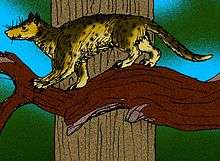Miacidae
Miacids are extinct primitive carnivoramorphans within the family Miacidae that lived during the Paleocene and Eocene epochs, about 62–34 million years ago. Miacids existed for approximately 28 million years.[3]
| Miacidae | |
|---|---|
 | |
| Miacis | |
| Scientific classification | |
| Kingdom: | Animalia |
| Phylum: | Chordata |
| Class: | Mammalia |
| Clade: | Carnivoramorpha |
| Clade: | Carnivoraformes |
| Family: | †Miacidae Cope, 1880 |
| Genera | |
| |
Miacids are thought to have evolved into the modern carnivorous mammals of the order Carnivora. They were small carnivores, superficially marten-like or civet-like with long, lithe bodies and long tails. Some species were arboreal, while others lived on the ground.[4]
They probably fed on invertebrates, lizards, birds, and smaller mammals like shrews and opossums. Their teeth and skulls show that the miacids were less developed than modern carnivorans. They had carnivoran-type carnassials, but lacked fully ossified auditory bullae (rounded protrusions).
Classification

Miacidae as traditionally conceived is not a monophyletic group; it is a paraphyletic array of stem taxa. Traditionally, Miacidae and Viverravidae had been classified in a superfamily, Miacoidea. Today, Carnivora and Miacoidea are grouped together in the crown-clade Carnivoramorpha, and the Miacoidea are regarded as basal carnivoramorphs. Some species of the genus Miacis are closely related to the order Carnivora, but only the species Miacis cognitus is a true carnivoran, as it is classified in the Caniformia.
The divergence of carnivorans from miacids is now inferred to have occurred in the middle-Eocene (ca. 42 million years ago).[5] Traditionally, the Viverravidae (viverravids) had been thought to be the earliest carnivorans, with fossil records first appearing in the Paleocene of North America about 60 million years ago, but recent cranial morphology evidence now places them outside the order Carnivora.[6] Later authorities disagreed, and propose that the viverravids arose in North America 65-60 million years ago, spread to Asia then later to Europe, and were the first carnivorans and possessed the first true pair of carnassial teeth.[7]:p8
It has been proposed that miacids arose in North America and Europe 50-60 million years ago then later spread to Asia.[8] Like the earlier viverravids, they possessed a true pair of carnassial teeth and therefore are related to order Carnivora.[9] They also possessed a full set of cheek teeth, were weasel to small fox sized, and lived in forests. All modern carnivorans arose from them.[7]:p9
Taxonomy
- Family Miacidae†
- Genus Eosictis
- Genus Messelogale[10]
- Genus Miacis
- Genus Miocyon
- Genus Oodectes
- Genus Palaearctonyx
- Genus Paramiacis
- Genus Paroodectes
- Genus Procynodictis[11]
- Genus Prodaphaenus
- Genus Quercygale[12]
- Genus Tapocyon
- Genus Uintacyon
- Genus Vassacyon
- Genus Vulpavus
- Genus Xinyuictis
References
- IRMNG (2018). Miacidae Cope, 1880 †. Accessed at: http://www.irmng.org/aphia.php?p=taxdetails&id=102911 on 2019-01-22
- "†family Miacidae Cope 1880 (carnivoran)" (html). Fossilworks. Retrieved 22 January 2019.
- "Miacidae in the Paleobiology Database". Fossilworks. Retrieved 2019-02-18.
- Cost, Ian N. (2013-10-02). "Extinct Animal of the Week: Before Things Got Dire". Extinct Animal of the Week. Retrieved 2019-02-18.
- "Ancestors". Red Wolf. Retrieved 2019-02-18.
- Polly, David, Gina D. Wesley-Hunt, Ronald E. Heinrich, Graham Davis and Peter Houde (2006). "Earliest Known Carnivoran Auditory Bulla and Support for a Recent Origin of Crown-Clade Carnivora (Eutheria, Mammalia)" (PDF). Palaeontology. 49 (5): 1019–1027. doi:10.1111/j.1475-4983.2006.00586.x.CS1 maint: multiple names: authors list (link)
- Wang, X.; Tedford, R. H. (2008). Dogs: Their Fossil Relatives and Evolutionary History. Columbia University Press. ISBN 978-0-231-13529-0. OCLC 822229250.
- "Miacis | extinct mammal genus". Encyclopedia Britannica. Retrieved 2019-02-18.
- "The Cat Survival Trust". www.catsurvivaltrust.org. Retrieved 2019-02-18.
- Morlo, M.; Schaal, S.; Mayr, G.; Seiffert, C. (2004). "An annotated taxonomic list of the Middle Eocene (MP11) Vertebrata of Messel" (PDF). Courier Forschungsinstitut Senckenberg. 252: 95–108. Retrieved 2008-05-18.
- Wesley, G.D.; Flynn, J.J. (2003). "A revision Of Tapocyon (Carnivoramorpha), including analysis of the first cranial specimens and identification of a new species". Journal of Paleontology. 77 (4): 769–783. doi:10.1666/0022-3360(2003)077<0769:AROTCI>2.0.CO;2.
- Wesley-Hunt, G.D.; Werdelin, L. (2005). "Basicranial morphology and phylogenetic position of the upper Eocene carnivoramorphan Quercygale". Acta Palaeontologica Polonica. 50 (4): 837–846. Retrieved 2017-02-25.